Top 5 Warmest Cities in Canada: Where Sunshine and Mild Winters Meet
It was mid-February in Canada, a month synonymous with icy winds and layers of snow that bury cities under a thick winter coat. As I pulled my jacket tighter during my morning walk in Ottawa, I couldn’t help but wonder: Was there a place in this vast northern country where winter wasn’t so harsh, where the sun graced the sky a little longer, and temperatures danced around a more tolerable level? The thought piqued my curiosity, sparking an adventure that led me to discover Canada’s hidden pockets of warmth—cities that don’t quite fit the chilly stereotype.
While Canada is renowned for its cold winters, some regions offer surprisingly mild weather, with gentle winters and pleasant summers. So, if you’re looking to escape the frosty chill but don’t want to leave the Great White North, here are the top five warmest cities in Canada that might just become your next sunny escape.
On the page:
1. Victoria, British Columbia: Canada’s Mildest City
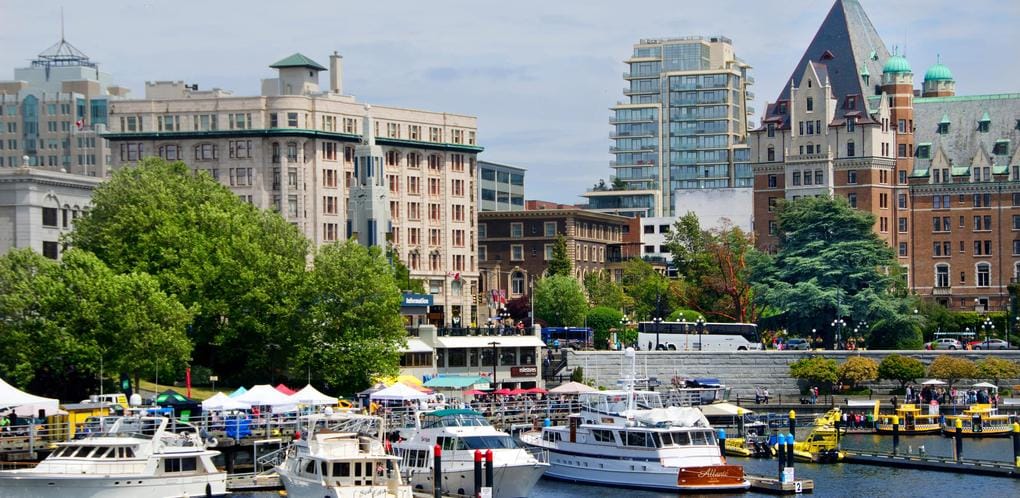
Victoria, the charming capital of British Columbia, stands out among Canadian cities not just for its historic beauty but also for its unique climate. Known as the warmest city in Canada based on year-round temperatures, Victoria enjoys an average annual temperature of around 11.2°C (52.2°F). Winters here are famously mild, rarely dipping below freezing, a refreshing break from the frigid temperatures typical of most Canadian cities.
Nestled on Vancouver Island, Victoria benefits from the moderating influence of the Pacific Ocean, which keeps temperature fluctuations minimal and provides the city with its mild, oceanic climate. Unlike most of Canada, Victoria’s winters are mostly wet rather than snowy. Though rain is common during winter, it is far less than what cities like Vancouver receive; Victoria averages only about 883 millimeters of rain per year. Summers, on the other hand, are pleasantly warm and dry, making Victoria a popular year-round destination.
Key Attractions and Activities
1. Butchart Gardens: One of Victoria’s must-see attractions, Butchart Gardens spans 55 acres and features meticulously curated floral displays, including themed gardens like the Japanese, Rose, and Sunken Gardens. Each season brings a new display of colors, with winter lights during the holiday season, spring blooms, and summer fireworks shows.
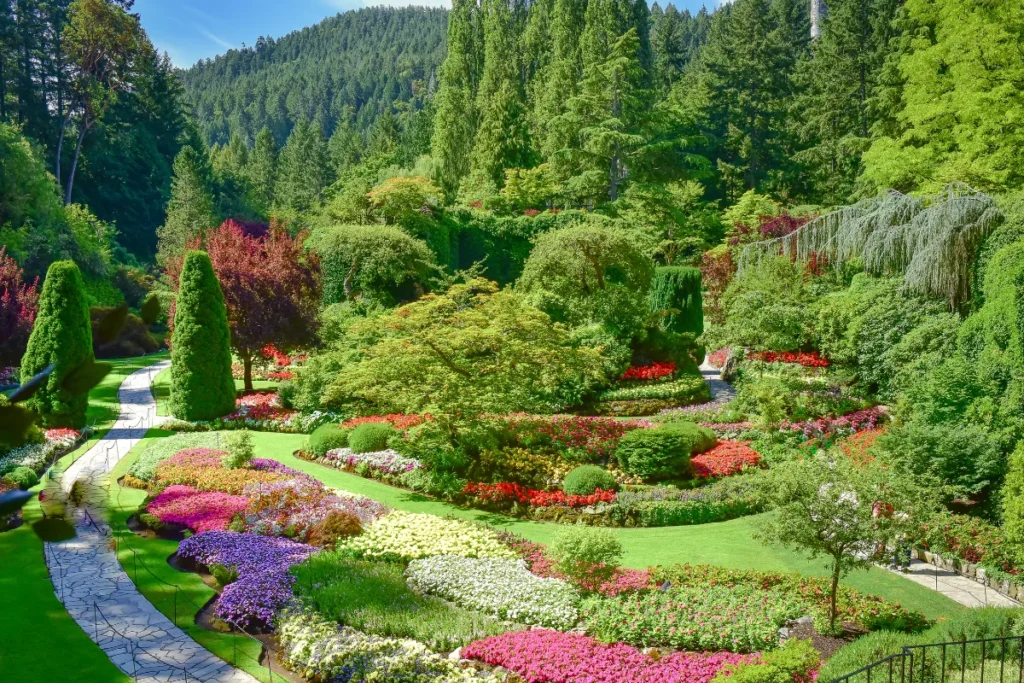
2. Inner Harbour and Parliament Buildings: Victoria’s Inner Harbour is a scenic area surrounded by historic architecture and bustling with activity. The British Columbia Parliament Buildings, with their iconic domes and lights that outline the structure at night, are a sight to behold. Visitors can take guided tours of the buildings to learn about provincial history and governance. Just across from the harbor, the Fairmont Empress Hotel stands as another landmark where visitors can enjoy an elegant afternoon tea experience steeped in British tradition.
3. Royal BC Museum: For history and culture enthusiasts, the Royal BC Museum offers a deep dive into British Columbia’s natural and human history. Exhibits cover everything from Indigenous cultures to the province’s colonial past and natural ecosystems. The museum’s immersive displays are especially appealing for families, offering interactive exhibits that bring history to life.
Outdoor Activities and Mild Climate Perks
Victoria’s mild climate means outdoor activities are accessible nearly all year round. Beacon Hill Park, located close to the Inner Harbour, offers picturesque gardens, ponds, and scenic viewpoints. The park is an excellent spot for picnicking, birdwatching, and leisurely strolls.

Whale Watching: Thanks to its coastal location, Victoria is one of the best places for whale watching in Canada. From April through October, visitors can book whale-watching tours to see orcas, humpback whales, and other marine life up close. The surrounding Salish Sea offers one of the richest marine ecosystems, making for a thrilling experience with professional guides and naturalists on board.
Cycling and Hiking: Victoria has an extensive network of biking and hiking trails, with Galloping Goose Regional Trail being one of the most popular. This scenic route covers 55 kilometers, stretching from downtown Victoria through beautiful landscapes and connecting with other parks and trails. For a more laid-back activity, visitors can enjoy leisurely bike rides along the Dallas Road Waterfront, offering fantastic views of the Olympic Mountains across the water.
Getting Around
Victoria is a walkable city, especially around the downtown core, where most major attractions are located. Public transportation, taxis, and bike rentals are widely available for those wanting to explore further. Victoria’s small size makes it easy to see much of the city without needing a car. However, visitors wishing to explore Vancouver Island’s natural attractions, like Pacific Rim National Park Reserve or Cathedral Grove, may consider renting a car for day trips.
Best Time to Visit
While Victoria’s mild winters make it a pleasant escape during Canada’s colder months, summer remains the peak season for tourism, particularly for outdoor activities. The warm, dry weather from June to September offers the best conditions for exploring gardens, hiking trails, and waterfronts, and is also when Butchart Gardens hosts their summer events.
With its mild climate, rich history, and vibrant culture, Victoria offers visitors a uniquely Canadian experience in a comfortably temperate setting year-round.
2. Vancouver, British Columbia: Where Urban Meets Nature
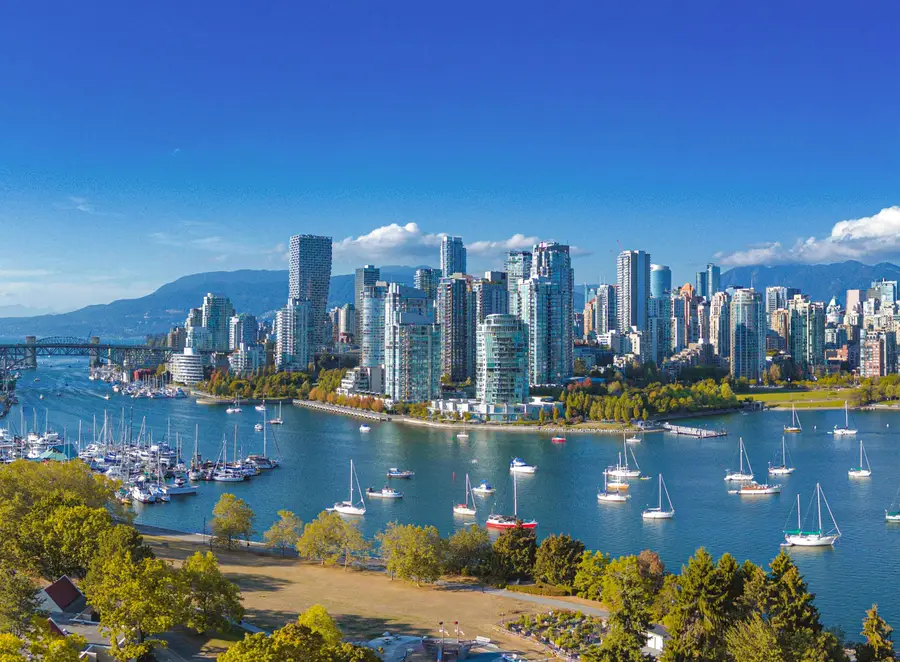
Vancouver, just a ferry ride away from Victoria, offers a unique blend of urban sophistication and natural beauty, along with a mild climate by Canadian standards. The city enjoys an average annual temperature of 10.2°C (50.4°F), giving it one of the warmest climates in Canada. Winters are more rainy than snowy, with temperatures rarely dipping below freezing, while summers are comfortably warm without the intense heat seen in other regions. Vancouver’s unique positioning between the mountains and the Pacific Ocean gives it this temperate, balanced climate, though winters are typically wet.
Snowfall in Vancouver’s city center is minimal, averaging only 8.4 days of snow per year. Most of the snow falls in nearby mountains, such as Grouse and Cypress, which are popular destinations for winter sports enthusiasts. This means you can enjoy skiing or snowboarding just a short drive from downtown while returning to milder, snow-free conditions within the city itself.
One of Vancouver’s greatest draws is its accessibility to both nature and urban amenities. Stanley Park, an iconic urban park, offers scenic seawall walks, forest trails, and beaches, while the vibrant downtown scene provides high-end shopping, fine dining, and arts venues. Visitors can easily spend the day outdoors exploring Vancouver’s extensive green spaces or skiing on nearby slopes, followed by an evening of world-class dining and entertainment.
In recent years, Vancouver has experienced warmer-than-average winters. In 2023, February temperatures reached an average of 9.5°C (49.1°F), well above historical norms, a trend likely linked to climate change and shifting global weather patterns. As Vancouver adapts, its warm, rainy winters remain a compelling alternative for those seeking Canada’s beauty without the extreme cold.
3. Kelowna, British Columbia: The Warm Okanagan Valley Gem
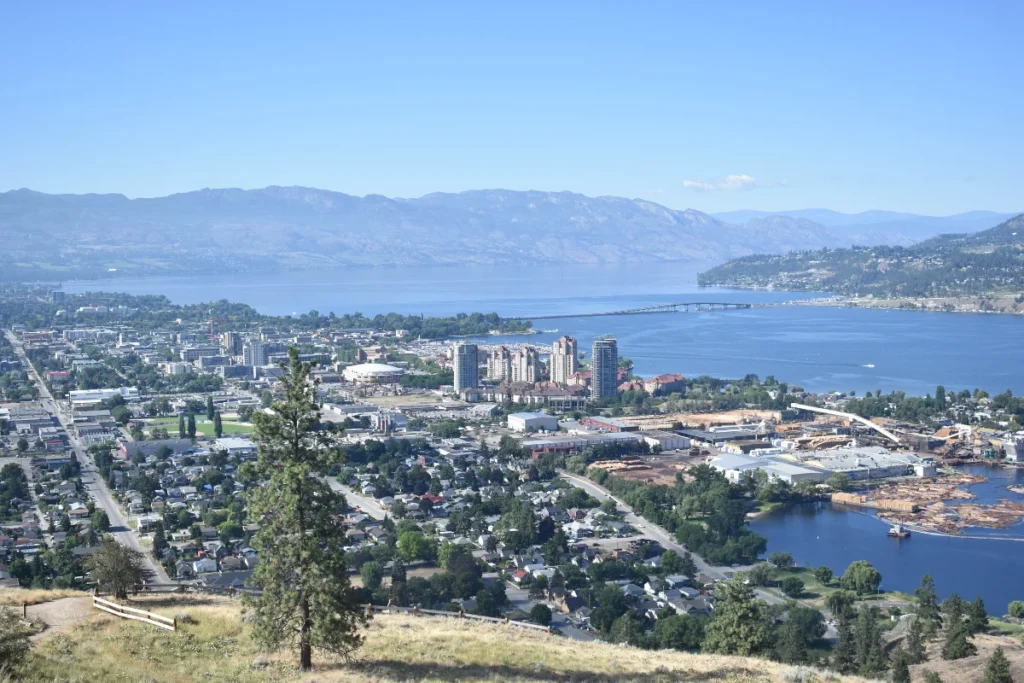
Heading inland from Canada’s coastal cities, Kelowna stands out as a sunny haven nestled in the picturesque Okanagan Valley. Known for its vineyards, stunning lake views, and vibrant outdoor lifestyle, Kelowna is one of Canada’s warmest cities, especially during summer. While the city’s average annual temperature is around 9.5°C (49.1°F), summer temperatures can soar into the mid-30s°C (mid-90s°F), making it a prime location for sun-seekers.
What really sets Kelowna apart is its dry, semi-arid climate—a notable contrast to the lush rainforests of Vancouver and Victoria. With over 2,000 hours of sunshine annually and just about 380 millimeters of rainfall, Kelowna is one of Canada’s sunniest and driest cities. This climate makes summer ideal for swimming in Okanagan Lake, enjoying water sports, or simply lounging on the beaches. The area’s unique climate also creates perfect conditions for grape-growing, and the Okanagan Valley has become one of Canada’s top wine regions, boasting award-winning wineries and tasting experiences.
Winter in Kelowna brings mild weather to the valley, while nearby mountains like Big White and Silver Star attract skiers and snowboarders. These ski resorts are close enough to allow visitors to enjoy the best of both worlds—exploring the snow-capped mountains by day and returning to Kelowna’s warmer valley climate by evening.
Fun Fact: Kelowna’s wine industry flourishes in its dry, warm climate, drawing wine lovers from around the world to taste its unique wines. A tour through the region’s vineyards is a must-do, offering a chance to sample acclaimed local vintages in a scenic setting.
Related: The 5 most beautiful cities in Canada that you absolutely must visit
4. Toronto, Ontario: Surprisingly Mild for Eastern Canada
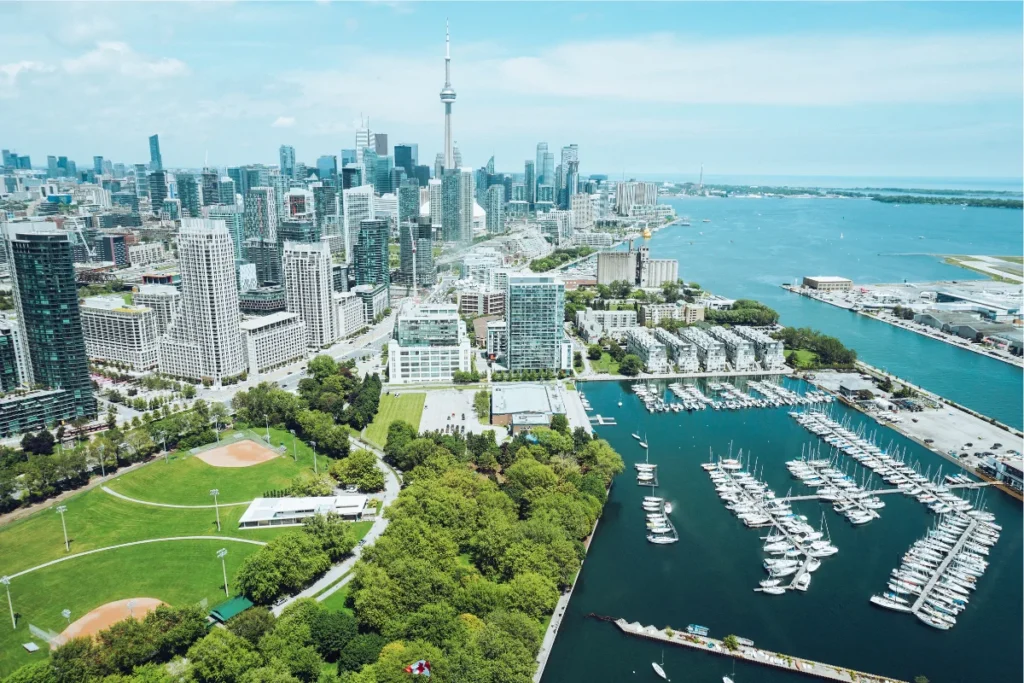
Toronto may not immediately come to mind as a warm city, but this bustling Canadian metropolis offers a surprisingly mild climate year-round, especially when compared to its eastern neighbors. With an average annual temperature of 9.1°C (48.4°F), Toronto enjoys a relatively temperate climate, largely due to its location on the shores of Lake Ontario. The lake acts as a natural temperature regulator, preventing extreme swings in temperature between seasons.
Global Warming Effects: Toronto has also begun to feel the effects of global warming, with milder winters and hotter summers becoming more common. In 2023, the city experienced record-breaking heat, including a 36.5°C (97.7°F) day in July, indicative of broader climate shifts. These rising temperatures have led to an increase in “extreme heat days,” prompting the city to implement cooling centers and other support systems to help residents stay safe during heat waves.
Dining, Culture, and Entertainment: Toronto’s diverse cultural landscape makes it a must-visit city for foodies and culture lovers. Known for its multicultural communities, the city boasts neighborhoods like Kensington Market, Chinatown, and Little Italy, each offering unique dining experiences and cultural events. Food lovers will appreciate the city’s food scene, from street food vendors to upscale restaurants featuring global cuisines. Art enthusiasts will find plenty to enjoy as well, with venues like the Art Gallery of Ontario and the Distillery District offering art installations, galleries, and performances.

Fun Fact: Toronto’s PATH system is the longest underground pedestrian network in the world, spanning over 30 kilometers (19 miles) and connecting major downtown buildings, shops, and public transit. This vast network allows residents and visitors to navigate the city’s downtown area comfortably during Toronto’s coldest days, making winter days a bit easier to handle.
Winter in Toronto: Winters in Toronto can certainly be chilly, but they’re often milder than in other parts of Ontario and the nearby eastern provinces. With about 50 days of snowfall per year, snow does make regular appearances, but it often doesn’t linger long, as winter temperatures tend to hover just above freezing. This results in a more manageable winter experience compared to the harsher climates further north. And for those particularly cold days, Toronto’s PATH system—a network of underground pedestrian pathways—offers over 30 kilometers (19 miles) of temperature-controlled walking paths through the downtown core, making it easy to stay warm while commuting or shopping.
Summer Climate and Outdoor Activities: Summers in Toronto are warm and humid, with July highs averaging around 26.3°C (79.3°F), though temperatures can spike higher on particularly hot days. Toronto is a vibrant city in the summer, bustling with outdoor festivals, waterfront activities, and events like the Toronto International Film Festival. The city’s numerous parks, including the sprawling High Park, offer green spaces for picnics, biking, and relaxing by the lake. The Toronto Islands, just a short ferry ride from downtown, are a favorite spot for locals and tourists alike, with beaches, bike rentals, and some of the best views of the city skyline.
Whether you’re exploring Toronto’s iconic CN Tower, strolling along the waterfront, or enjoying its many festivals and cultural hubs, Toronto’s moderate climate and vibrant urban scene make it an attractive destination year-round.
5. Halifax, Nova Scotia: A Maritime Mildness
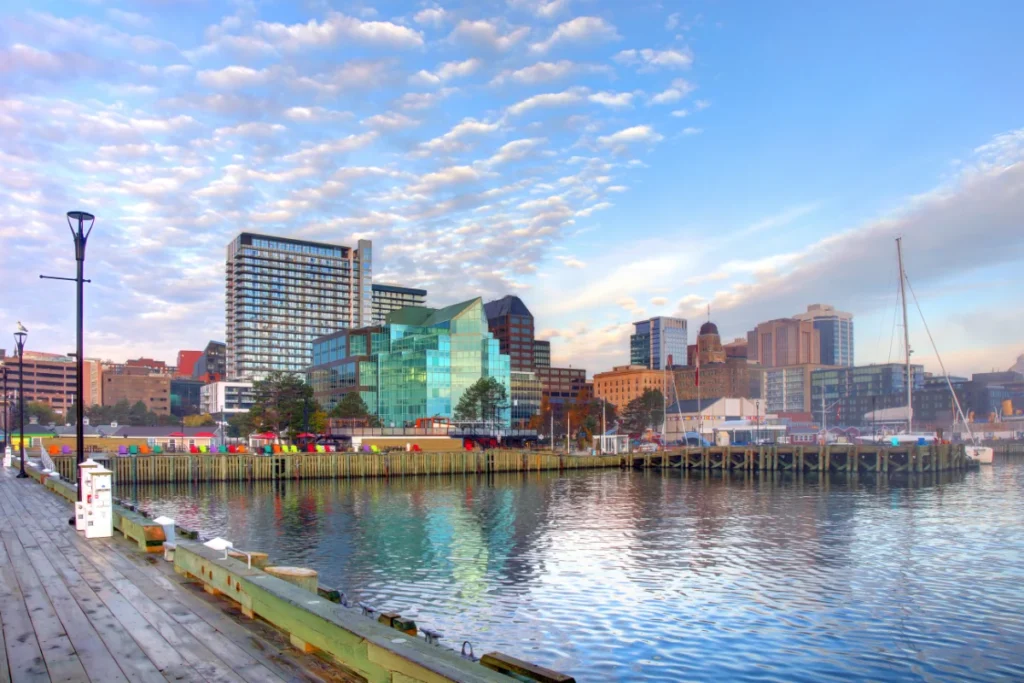
On Canada’s East Coast, Halifax offers a captivating blend of maritime charm, rich history, and a surprisingly mild climate that sets it apart from the harsher winters typically associated with the region. With an average annual temperature of 8.9°C (48°F), the city experiences winters that are moderated by the Atlantic Ocean, allowing for temperatures that are often warmer than Canada’s inland cities.
Winter in Halifax does come with snow, but its maritime climate means that rain is just as common, especially during warmer winter days when temperatures hover around 0°C (32°F). Snowfall is frequent but often melts quickly, and temperature fluctuations are common, where a cold day can swiftly transition to a milder, rainy one. For travelers who prefer avoiding heavy snowfall, Halifax’s winter climate offers a manageable and scenic option on the East Coast.
In summer, Halifax boasts comfortable temperatures, rarely exceeding 26°C (79°F). The cool ocean breezes make it an ideal retreat for those looking to avoid the intense heat of Canada’s interior regions. Summers are also prime for exploring Halifax’s stunning waterfront, historic landmarks, and outdoor festivals. The Halifax Waterfront Boardwalk, one of the longest in the world, is a must-visit, stretching 4 kilometers (2.5 miles) along the harbor and dotted with shops, restaurants, and historical sites like the Canadian Museum of Immigration at Pier 21.
Explore Historic Landmarks: Halifax is steeped in history, dating back to its founding in 1749. History buffs will appreciate visiting Citadel Hill, a star-shaped fort that has stood guard over the city since the 18th century. Here, visitors can take guided tours, watch reenactments, and enjoy panoramic views of the city and harbor.
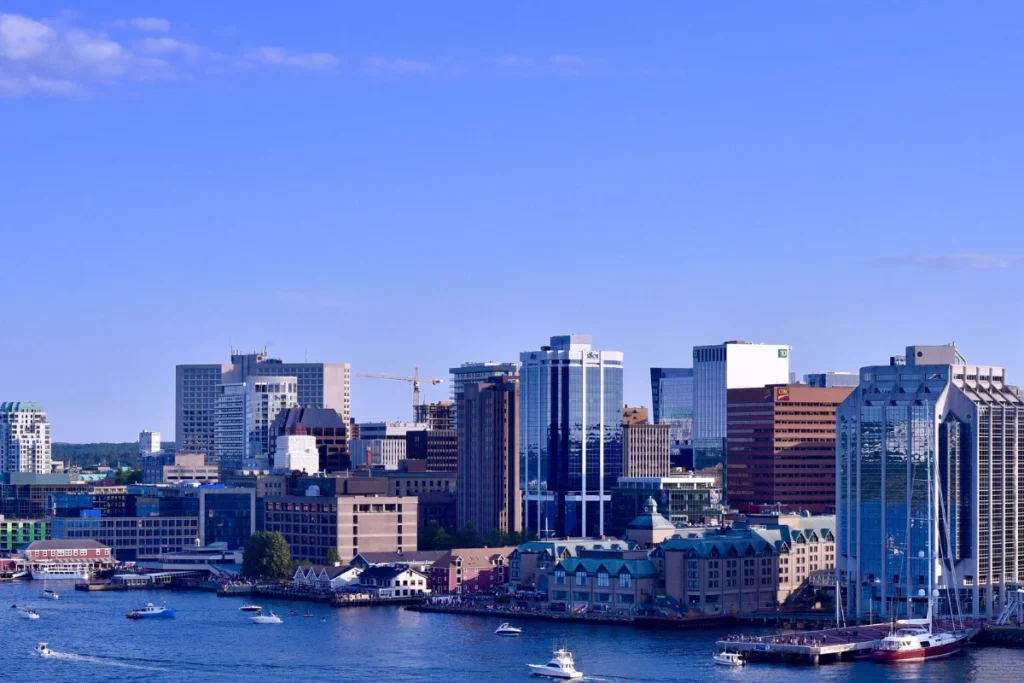
Maritime Adventure: Halifax’s close ties to the sea make it a haven for maritime enthusiasts. A trip to Fisherman’s Cove, a charming restored fishing village, offers a peek into Nova Scotia’s seafaring culture. For a deeper dive into the area’s nautical past, the Maritime Museum of the Atlantic showcases artifacts from the Titanic, which famously sank off Nova Scotia’s coast.
Nature and Relaxation: The ocean’s influence extends beyond the city to nearby natural sites. A short drive from Halifax, Peggy’s Cove offers one of Canada’s most iconic coastal views, with a picturesque lighthouse perched atop granite rocks facing the Atlantic. Further along the coast, Lawrencetown Beach is ideal for surfers and beach lovers alike. Summer brings perfect conditions for kayaking and paddleboarding, while winter provides brisk coastal walks that showcase the rugged beauty of Nova Scotia’s shoreline.
Dining and Nightlife: Halifax’s vibrant food scene embraces both traditional seafood dishes and modern culinary trends. Seafood lovers should try fresh Atlantic lobster or Digby scallops, often available at waterfront restaurants. In the evening, Halifax’s lively pubs and music venues come alive, with local bands and a welcoming East Coast vibe that make for a memorable night out.
Fun Fact: Halifax is one of Canada’s foggiest cities, with around 122 foggy days per year. This fog, created by the meeting of the warm Gulf Stream and the cold Labrador Current, gives Halifax a mystical quality, adding to its coastal allure. Whether exploring historic sites, taking in the sea air along the waterfront, or diving into its maritime culture, Halifax offers a uniquely East Coast experience that blends charm, history, and outdoor beauty.
Conclusion: Where Would You Choose to Live?
Canada may have a reputation for being an icy frontier, but these five cities prove that there are plenty of warm havens to be found. Whether you’re seeking the mild winters of Victoria and Vancouver, the sun-soaked summers of Kelowna, or the maritime charm of Halifax, Canada offers a diverse range of climates for those looking to escape the cold. Climate change is also playing a role, with temperatures rising across the board, making these already warm cities even more attractive.
Wherever you choose to settle, one thing is for sure: warmth and comfort can indeed be found north of the 49th parallel. So, pack away that heavy coat and get ready to explore the warmer side of Canada!
References:
- Environment Canada – Average Annual Temperature Data.
- Canadian Climate Normals – Weather and Climate Statistics.
- “Global Warming in Canadian Cities” – Scientific Research Journal, 2023.
- City of Victoria – Official Tourism Data.
- City of Vancouver – 2023 Weather Records .
- Toronto Weather Records – July 2023 Report .
- Halifax Fog Data – Nova Scotia Weather Trends .




2 thoughts on “Canada’s Top 5 Warmest Cities Today”